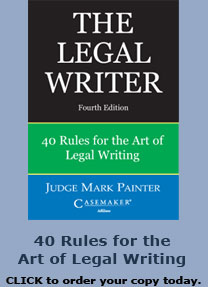A classic example of bad writing
By Judge Mark P. Painter
In my last column I gave kudos to the U.S. Supreme Court and its rules committee for rewriting the Federal Rules of Civil Procedure in plain language. But the fight goes on. Legislative drafting continues to be particularly egregious.
Here is an example from the Ohio “Revised” Code: (I am not making this up.)
If the agency determined that the petitioner is an adopted person, if the department of health informed the agency either that the file of releases does not contain a release or releases filed by one or both of the petitioner’s biological parents that authorize the release of identifying information to him and does not contain a release or releases filed by any biological sibling that authorizes the release of specified information to him or that the file of releases contains at least one such release but a withdrawal of release has been filed that negates each such release, if the agency did not inform the court that it had determined that one or both of the petitioner’s biological parents as indicated on the petitioner’s original birth record were deceased, and if the court did not determine that one or both of the petitioner’s biological parents as indicated on that record were deceased, the judge shall order that the petition remain pending until withdrawn by the petitioner and order the department of health to note its pendency in the file of releases according to the surname of the petitioner as set forth in his original birth record; shall inform the petitioner that he is an adopted person and, if known, of the county in which the adoption proceedings occurred; shall inform the petitioner that information regarding his name by birth and the identity of his biological parents and biological siblings may not be released at that time because the file of releases at that time does not contain an effective release that authorizes the release of any such information to him; and shall inform the petitioner that, upon the subsequent filing of a release by or the death of either of his biological parents, or the subsequent filing of a release by any of his biological siblings, the petition will be acted upon within thirty days of the filing in accordance with division (E) of this section.
Don’t skip it, as most readers would. Really read it – but just once. A 326-word sentence! As we know, even sophisticated readers have trouble with any sentence of more than 35 words. This one is unfathomable. It has a readability score of 0. And it’s about adoption – something “normal” people should be able to understand.
Let’s try a revision:
(A) If the agency determines that the petitioner is an adopted person, then the agency must determine whether
(1) the file of releases does not contain a release or releases by one or both of the petitioner’s biological parents or by any biological sibling that authorize the release of identifying information to him; or that the file contains at least one release but that release has been withdrawn; and
(2) neither of the petitioner’s biological parents as indicated on the petitioner’s original birth record is deceased.
(B) If the agency determines both 1) and 2), then the judge shall order that the petition remain pending until withdrawn by the petitioner. The judge shall also
(1) order the department of health to note its pendency in the file of releases according to the surname of the petitioner as set forth in his original birth record;
(2) inform the petitioner that
(a) he is an adopted person and, if known, of the county in which the adoption proceedings occurred;
(b) information regarding his birth name and his biological parents and biological siblings identity may not be released at that time because the file of releases does not contain an effective release; and
(c) upon the later filing of a release by or the death of either of his biological parents, or a release by any of his biological siblings, the petition will be acted upon within 30 days of the filing according to division (E) of this section.
This gets it to 236 words, a real improvement. And a more readable structure, I think.
But let’s keep trying:
(A) If the petitioner is adopted, if the file does not contain a current release by one of his biological parents or siblings authorizing the releasing the identifying information to him, the court must determine whether both of his biological parents are still living.
(B) If there is no valid release and both parents are still living, the judge shall order that the petition remain pending until withdrawn by the petitioner. The health department shall note its pendency in the file of releases under the petitioner’s surname in his original birth record.
(C) The judge shall also inform the petitioner that
(a) he is adopted and, if known, the county where the adoption occurred;
(b) his birth name and biological parents and siblings identity may not be released because there is not an effective release on file; and
(c) if an effective release is filed or either of his biological parents dies, the petition will be acted on within 30 days.
Down to 155 words – fewer than half the original – and we even get a readability score (38)! I did this in about an hour – it could probably be improved further. But shouldn’t legislatures invest that much time?
____________________________________
Mark Painter has served as a judge on the Ohio First District Court of Appeals for 11 years, after 13 years on the Hamilton County Municipal Court. Judge Painter is the author of The Legal Writer: 40 Rules for the Art of Legal Writing. It is available from http://books. lawyersweekly .com. Judge Painter has given dozens of seminars on legal writing. Contact him through his website, www.judge painter.org.








